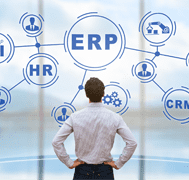 Enterprise Resource Planning (ERP) software provide a suite of integrated applications that allow an organization to process data from its entire host of operations from inventory to orders, HR department to employees in the field, both B2C and B2B sectors, accounting, and more.
Enterprise Resource Planning (ERP) software provide a suite of integrated applications that allow an organization to process data from its entire host of operations from inventory to orders, HR department to employees in the field, both B2C and B2B sectors, accounting, and more.
Put simply, ERP software can encompass every facet of a company’s data. Not surprisingly, one study showed ERP implementation led to business process improvement for 95 per cent of businesses.
When implementing ERP, companies have two major options to consider.
On-premise ERP
On-premise ERP software is installed and hosted locally on a company’s in-house computers and servers. Until recently with the onset of cloud computing, on-premise ERP was industry standard.
It’s usually a one-time perpetual license fee where companies make a large upfront investment followed by recurring fees for support, training, and potentially updates, depending on the software. Companies can also build their own custom on-premise ERP according to their needs.
Cloud-based ERP
Cloud-based ERP is hosted on a vendor’s servers and accessed online. Generally, cloud-based ERPs are priced monthly, so the initial costs are lower for smaller companies who don’t have the capital to invest in hardware like servers. One survey found that over 20 per cent of companies are using cloud-based ERP systems.
Advantages and Disadvantages
The immediate advantages for cloud-based ERPs are their scalability. Companies don’t require hefty upfront capital to take advantage of ERP capabilities. Cloud-based vendors also manage updates and bug fixes, which means companies can defer these responsibilities—usually at no additional cost.
Many cloud-based ERPs are out-of-the box and designed for specific industries, making them easy to use and implement. A cloud-based ERP is ideal for companies that don’t need a lot of customization as the software’s configurations are designed to meet the needs of most users in the provider’s targeted industry.
If a company needs a lot of customization, a cloud-based ERP may not be the right solution. On-premise ERP offers complete control of data processes by using your own IT infrastructure. The downside is the company will have to take on costs for hardware, maintenance, and security, so it’s only feasible for companies that can handle that level of upfront investment.
There’s also some concern that hosting sensitive data on the cloud can raise privacy concerns. Because on-premise maximizes customization, companies can optimize their own privacy according to their needs. That being said, cloud computing offers its own sophisticated layers of security. For example, Microsoft Azure offers a broad set of policies, tech, and controls that most companies couldn’t match in-house.
We can help you navigate the differences between on-premise and cloud-based ERP and define the pros and cons of each to help you make a smart business decision for your new ERP. Contact us at https://sheaglobal.com.